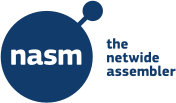Netwide Assembler
 | |
| Original author(s) | Simon Tatham, Julian Hall |
|---|---|
| Developer(s) | H. Peter Anvin, et al. |
| Stable release | 2.11 / January 20, 2014 |
| Operating system | Microsoft Windows, Unix-like, OS/2, OS X, DOS |
| Available in | English |
| Type | x86 assembler |
| License | 2-clause BSD |
| Website | www.nasm.us |
The Netwide Assembler (NASM) is an assembler and disassembler for the Intel x86 architecture. It can be used to write 16-bit, 32-bit (IA-32) and 64-bit (x86-64) programs. NASM is considered to be one of the most popular assemblers for Linux.[1]
NASM was originally written by Simon Tatham with assistance from Julian Hall and is currently maintained by a small team led by H. Peter Anvin.[2] It is available as free software under the terms of the simplified (2-clause) BSD license.[3]
Features
NASM can output several binary formats including COFF, Portable Executable, a.out, ELF, Mach-O and .bin (binary disk image, used for compiling operating systems), though position-independent code is only supported for ELF object files. NASM also has its own binary format called RDOFF.[4]
The variety of output formats allows programs to be retargeted to virtually any x86 operating system. In addition, NASM can create flat binary files, usable in writing boot loaders, ROM images, and in various facets of OS development.[4] NASM can run on non-x86 platforms, such as SPARC and PowerPC, though it cannot generate programs usable by those machines.
NASM uses a variation of Intel assembly syntax instead of AT&T syntax.[5] It also avoids features such as automatic generation of segment overrides (and the related ASSUME directive) used by MASM and compatible assemblers.[4]
Examples of programs for various operating systems
This is a Hello world program for the DOS operating system.
section .text org 0x100 mov ah, 0x9 mov dx, hello int 0x21 mov ax, 0x4c00 int 0x21 section .data hello: db 'Hello, world!', 13, 10, '$'
An example of a similar program for Microsoft Windows:
global _main extern _MessageBoxA@16 extern _ExitProcess@4 section code use32 class=code _main: push dword 0 ; UINT uType = MB_OK push dword title ; LPCSTR lpCaption push dword banner ; LPCSTR lpText push dword 0 ; HWND hWnd = NULL call _MessageBoxA@16 push dword 0 ; UINT uExitCode call _ExitProcess@4 section data use32 class=data banner: db 'Hello, world!', 0 title: db 'Hello', 0
An equivalent program for Linux:
global _start section .text _start: mov eax, 4 ; write mov ebx, 1 ; stdout mov ecx, msg mov edx, msg.len int 0x80 mov eax, 1 ; exit mov ebx, 0 int 0x80 section .data msg: db "Hello, world!", 10 .len: equ $ - msg
Linking
NASM principally outputs object files, which are generally not executable in and of themselves. The only exception to this are flat binaries (e.g., .COM)[4] which are inherently limited in modern use. To translate the object files into executable programs, an appropriate linker must be used, such as the Visual Studio "LINK" utility for Windows or ld for UNIX-like systems.
Development
On 28 November 2007, version 2.00 was released, adding support for x86-64 extensions.[2] The development versions are not uploaded to SourceForge.net; instead, they are checked in to the project's own Git repository with binary snapshots available from the project web page.
A search engine for NASM docs is also available.[6]
As of version 2.07, NASM is now under the Simplified (2-clause) BSD license.
See also
- Assembly language
- List of assemblers
- Yasm
References
- ↑ Ram Narayan. "Linux assemblers: A comparison of GAS and NASM". "two of the most popular assemblers for Linux, GNU Assembler (GAS) and Netwide Assembler (NASM)"
- ↑ 2.0 2.1 "The Netwide Assembler". Retrieved 2008-06-27.
- ↑ "NASM Version History". Retrieved 2009-07-19.
- ↑ 4.0 4.1 4.2 4.3 "NASM Manual". Retrieved 2009-08-15.
- ↑ Randall Hyde. "NASM: The Netwide Assembler". Retrieved 2008-06-27.
- ↑ "NASM Doc Search Engine". Retrieved 2009-09-14.
Further reading
- Jeff Duntemann (2000). Assembly Language Step by Step. J Wiley and Sons. ISBN 0-471-37523-3.
External links
- NASM website
- SourceForge Page
- Special edition for Win32 and BeOS.
- A comparison of GAS and NASM at IBM
- intel2gas : a converter between the source format of the NASM and GAS assemblers
| |||||||||||